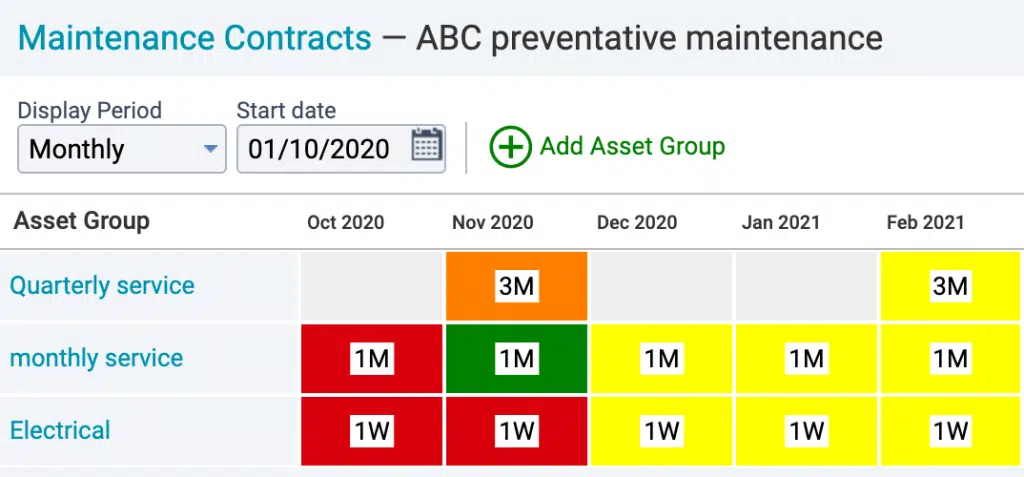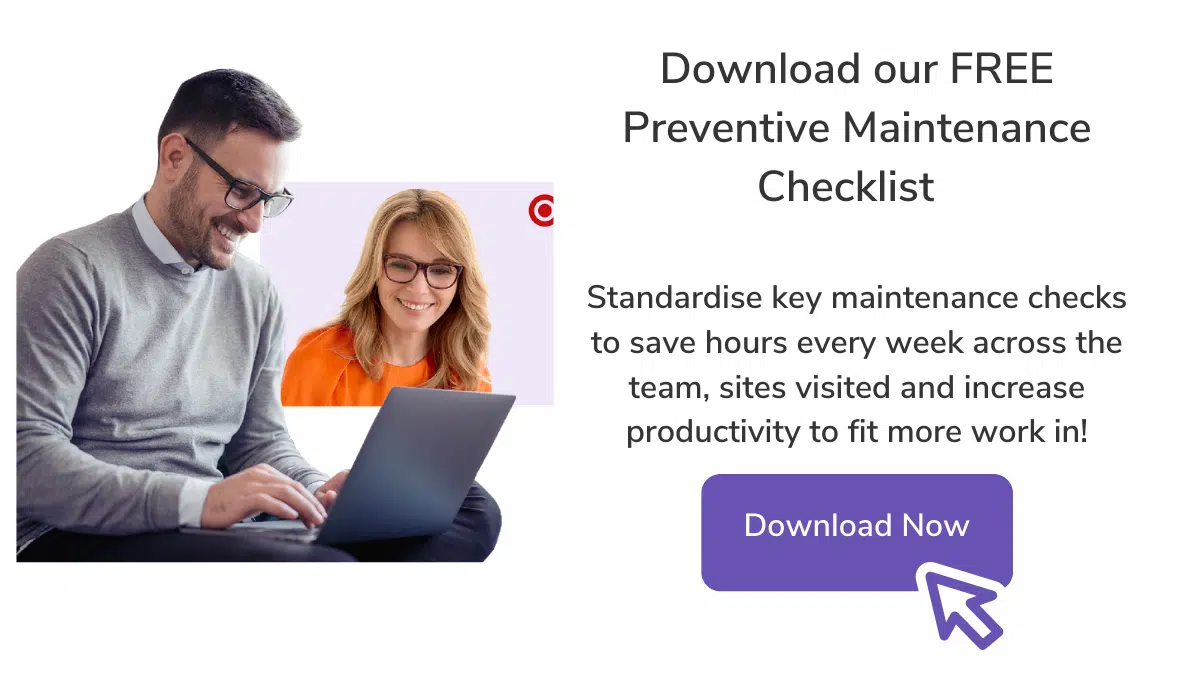12 Preventative Maintenance Best Practices To Follow
If you are in the field service industry, don’t wait for the nightmare of a burning HVAC units to come knocking on your door. If you have a great preventative maintenance plan documented in your business, you can go back to peacefully counting sheep knowing the units aren’t going to spontaneously combust due to lack of planned maintenance.
At a simple level, preventative maintenance is the process of gathering equipment/asset information to then track the life cycle against the cost of the unit. Ideally you want this to be done using consistent and repeatable approach that is efficient and allows you to produce testing results quickly for the customer and identify any defects to handle early.
Having a maintenance plan is the activity of regular servicing to ensure optimal levels of performance are achieved. While this sounds simple enough, preventive maintenance becomes complicated with the increase in number of assets and customers you take on contracts for. When you find yourself feeling overwhelmed you might need to take a look at some of the key workflows and policies in your business.
Below are considerations we think are important when considering planned preventative maintenance workflows.
What is preventive maintenance?
Preventive maintenance is typically used in the field service industry to maintain and upkeep assets, this can be performed annually, seasonally, monthly or even weekly depending on your asset type and manufacturer’s recommendations. One of the main goals of preventive maintenance is to reduce the likelihood that an asset will experience unplanned breakdowns, failure, or need major repairs. Preventive maintenance can proactively work towards maintaining asset longevity and peak performance. Therefore reducing unexpected repair costs or disruptions.
Different types of maintenance
Condition based vs preventive maintenance. What’s the difference? There are four main types of preventive maintenance; condition based, preventive, corrective, and risk based.
- Corrective maintenance: This type of maintenance focuses on the operation of the asset and will only recommend maintenance if performance is lowered or a defect is found.
- Preventive maintenance: a proactive approach that fixes the problems before they occur at set intervals.
- Risk based maintenance: Based on data and tests, this will vary maintenance depending on any abnormalities that are detected.
- Condition based maintenance: In this type of maintenance, an asset is only worked on if the condition of the asset changes.
Common challenges of preventive maintenance
While there are lots of benefits to preventive maintenance, there are also some downfalls that can occur if you don’t have the right systems in place:
- No clear schedule
- Unprepared technicians
- No job descriptions
- No outlined job steps
- No visibility over work completed
- No defect follow up
- Lack of recorded data and history
Below are considerations we think are important when considering planned preventative maintenance workflows.
1. Planning
A maintenance PM plan should ideally be an exercise that increases communication and be done in a few simple steps. Unfortunately that is not the case with many HVAC businesses who use whiteboards, spreadsheets and paper diaries to track their work. Without the correct preventative planning you will find you have to manage a lot of rework, double data entry and weeding through inaccurate or irrelevant information.
When you get the planning right you create a transparent system from a central place across all the assets you manage. Simple techniques that can dramatically reduce the long and mundane admin so you can focus on customer communication and team management.
2. Time effective & Visual Preventative Maintenance Scheduling
When you have a busy schedule with a large team to manage, having high visibility amongst all the interested parties (customer, technician and the office) in critical. When you are in a position where the team can access the right information on site quickly and complete their testing, checks without delay the office can keep up with the reporting and this saves minutes to hours of admin – time back to focus on growth activities is very powerful.
When the office has a full view of all the work for the month then allocation of technician based on skill and activity level can be planned out – being able to resource allocate efficiently means you can find spots to quote more work and complete important tasks like inventory management to help with cost management.
You need preventive maintenance software to help you manage streamlined planned maintenance workflows.

Simple Preventative Maintenance
3. Maintenance History
Keeping track of every visit and activity or interaction with an asset can be hard. Do you find yourself on a site to do one task and realise you could complete other tasks but you dont have any information on the other assets on site and where they are up to. You could attempt to call the office to find the information but that puts pressure on them whilst you are waiting in the van until they call you back. These small time wasters can cost a HVAC business productivity and reduce efficiencies across the team. All Service teams want to run an efficient team so finding the time wasters and optimising those workflows is key.
Developing good practices about the maintenance information you collate about an installed asset means everything knows exactly what information to check/validate when on site and what checks./tests are next required. If you don’t have a good maintenance history in your business you may find it hard to verify when customers have queries or something goes wrong (a broken pipe or electrical fault).
Imagine if you have an asset fail that you have serviced correctly, but you have no proof that you’ve been maintaining that system? In many cases you can end up liable for costs and you’ll have one unhappy customer.
When you have your asset history at your fingertips you have visibility needed to keep the maintenance contract on schedule/target and keeping the customers happy. Asset tracking can be vital to ensuring your business runs smoothly and your team has the confidence to get the job done right.
4. Repeatability
Inconsistency can be the death of a successful business in the field service industry and can be a great source of frustration all the team; Schedulers do things differently confuses the Tech’s and the Tech’s never complete the tasks or job information correctly that means the office cant complete Service reports or Invoicing.
When you introduce standardisation (or systemised processes) and consistently apply these across your maintenance program, through workflows using commercial pm inspection checklists , you will find quality of work improves for both the asset and the data you need internally.
Having documented guides/training materials will help you train your team and adapt your workflow in a fluid manner that is always optimising efficiency.
5. Change Management
Change management is arguably one of the hardest parts of a CMMS (Computerised maintenance management system). Most people dont like change and will resist but the flip side is after you introduce standardisation of workflows and provide the right training most will say the new way of working is much simplier or easier and they gain a sense of achievement through increased productivity and accuracy in tasks completed.
In your go-to business plan, change management is a vital part of ensuring your workflows are optimised and the team has the tools and training to overcome the resistance of these changes. Change management is largely a mental process that you and your team need to go through, to understand where the problems are and how you can improve and explain to them them what the changes will mean for the business as a whole;
- ability to quote and take on more planned preventative maintenance contracts
- grow the team
- specialise in to a segment
- offer superior preventive maintenance experience across the industry
- be more profitable
(If you run a HVAC business, check out our free guide on HVAC business plans and models)
6. Challenges
With growth you will inevitably reach a point where current workflows/systems (ie paper based, white board or spreadsheet systems) no longer cut it. You will know this when you starting seeing/hearing;
- I have to stay back late every day to complete the service reports because ….
- The phone bill increases month on month with all the to/fro calls between office and tech to follow up missed information
- Unnecessary calls backs because you didnt schedule the correct test and didnt have the parts
When preventative maintenance scheduling goes wrong you experience bad communication, poor mapping, wasting time and a lack of knowledge amongst your team. All these challenges and more can be solved with FieldInsight’s field service management software, leveraging the team who shares a love for improving business performance through software automation.
7. The implementation of software automation allows for competitive execution
With a CMM& field service automation software, you gain the advantage of standardisation and automation increasing efficiency in your workflows. To stay competitive you have to have a systems mindset and a goal to be as efficient as possible. Gaining competitive advantage should be a standard you wish to achieve and once achieved becomes ingrained in your business culture and reviewed regularly to see if there is more than can be achieved. A business that hasn’t changed operations in the last 5 years is a business that may be less profitable per contract/job that a competitor doing the same volume of work.
The less time spent on follow-up or admin is more time spent managing and optimising a profitable and efficient business. To stay competitive and keep up with the Jones’s, you need field management software that will help you with managing preventive maintenance contracts so that you can continue to build on your business’s strengths.
8. Equipment information to ensure the right parts are ready
Having the right information at the touch of your fingertips like a model number, a unit diagram/schematic, inspection checklist or a work order can save valuable time in the field. Having a true view of the next event (maintenance/service milestone) before you attend the site means you can pre-plan the relevant parts and information required. taking the time to plan these key scheduling events will save time when the technician is on site. You want to keep the technicians moving quickly between jobs, calling the office or doing a trip to the supplier is wasted time – this eats in to the margin on the job.
When you need to order spare parts for a HVAC unit, you want to have the information they need to make ordering faster. When you have to wait to track down a serial number for spare parts, you can delay projects significantly. When you have a fast reactive system supporting your maintenance schedule, your business is one step closer to success.
9. PM preventative maintenance checklists
Preventative maintenance work relies heavily on consistency and checklists are a very powerful tool to help standardise what happens on site. Preventative maintenance tasks coupled with an optimised workflow can allow you to identify opportunities and mistakes stop little steps being missed.
A planned preventive maintenance plan is always better than reactive repair activity as you are able to prevent defects from developing or can identify them early. Having checklists that are easy to configure and contain only the checks needed for the specific visit planned you reduce the amount of time your technicians will spend on servicing the asset and optimising the parts used and the up side is increase reliability of the asset for the customer.
10. Culture (discipline)
Culture is a very emotional and often forgotten side of the business. Creating a culture that you are proud of and resonates in to your brand means you become the Go To employer in the industry as well as attract the right type of customers.
Ensure your plan includes a section on your goals for Culture and is reviewed strategically on a regular basis (minimum annually). The main thing that can impact culture is bad hires and they can completely destroy a company’s culture. Ensuring everyone signs up to the standards of the culture you want to achieve and be quick to identify as well as handle breaches.
11. Hiring the right technician team
Ask yourself…have you hired the right team? Hiring can be a tricky process and can result in having people on the team that aren’t a great match and can be counter-productive to your workflow.
When looking to hire technicians for the field, you should always hire in an unbiased way, based purely on characteristics you want, not because it’s a friend or family member. It can always be helpful to get a fresh pair of eyes to assist in hiring so you are making an informed decision.
Massive companies like McDonald’s have this process aced and hire staff that build great dynamics and all they do it is provide the systemisation to do their jobs.
(If you’re interested more in how to manage your field team, we’ve put together a free guide on how to schedule and dispatch service technicians here)
Technician working on HVAC Unit
12. Monitor KPIs, Quotes and Costing to Deliver for clients and stay profitable
Measuring the success of your preventative maintenance projects from a cost point of view and the lense of customer satisfaction is going to assist you in tracking progress in your business. Find the areas where expenses are running above margins and tighten the wallet. Managing your inventory in a smart way will save thousands of dollars.
When you have insight into your costs, KPIs and quotes, you can better apply controls such as purchasing. Rewarding outstanding behaviour and pulling up bad behaviour is also a key to managing costs. With this level of attention to detail your team is delivering to the highest level of quality and processing towards business goals.
money and paper flying around
Benefits of using a maintenance software…
Preventive maintenance best practices help build reliability into your business and offer benefits…
- Simplified workflow with high visibility across all the roles
- A centralised system – all your information in one place
- Less asset downtime – you’ll catch defects before they cause issues
- Repeatability in your technician’s maintenance (i.e. checklists)
- Maintain standards and contract requirements – with great maintenance practices and scheduling, you’ll never miss a service for a customer again
- Achieve extended life cycle and efficiency of assets that have been regularly maintained
- Systemisation saves you time and is more cost effective
For a management software that will put your business on the map, check out FieldInsight today! With a preventive maintenance program like FieldInsight, you will have the equipment you need to avoid failures in your workflow.
What You Should Do Now
- Book a Demo. You’ll be in touch with an automation expert who has worked in this space for over 5 years, and knows the optimal workflow to address your needs.
- If you’d like access to free articles about managing HVAC workflows, go to our blog.
- If you know someone who’d enjoy reading this page, share it with them via email, Linkedin, Twitter, or Facebook.




